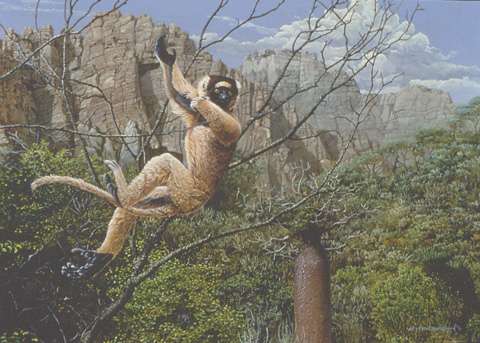Verreaux's Sifaka
(1996)

Acrylic on
illustration board
14" x 20"
| The
fantastic island of Madagascar, having been isolated since the
Cretaceous, is famous for its unique flora and fauna. The 32
species of primate living there are usually referred to collectively
as "lemurs", though they are not all closely related.
The elegant Verreaux's sifaka (pronounced sh'fock) is one of
the most beautiful of the lot. Found mostly in dry forests in
the west and southern part of the island, it is strictly herbivorous,
eating leaves and fruits when they are available. Like its relatives,
the indri and the avahis, the diurnal sifaka is most comfortable
when clinging to a vertical tree trunk. From this position it
can leap powerfully from tree to tree. When moving about on the
ground, it does so bouncing bipedally like a kangaroo. Its ability
to leap about the trunks of plants of the family Didiereaceae,
which are covered with large strong spines, without injury is
a feat that continues to perplex observers. The landscape in
the painting is purely invented but is meant to simulate the
southwestern edge of Madagascar's central plateau. The incidental
creatures are: Oustalet's chameleon (Furcifer oustaleti),
Madagascan day gecko (Phelsuma madagascariensis), Madagascan
kestrel (Falco newtoni), Namaqua dove (Oena capensis),
and ring-tailed lemurs (Lemur catta). |
|